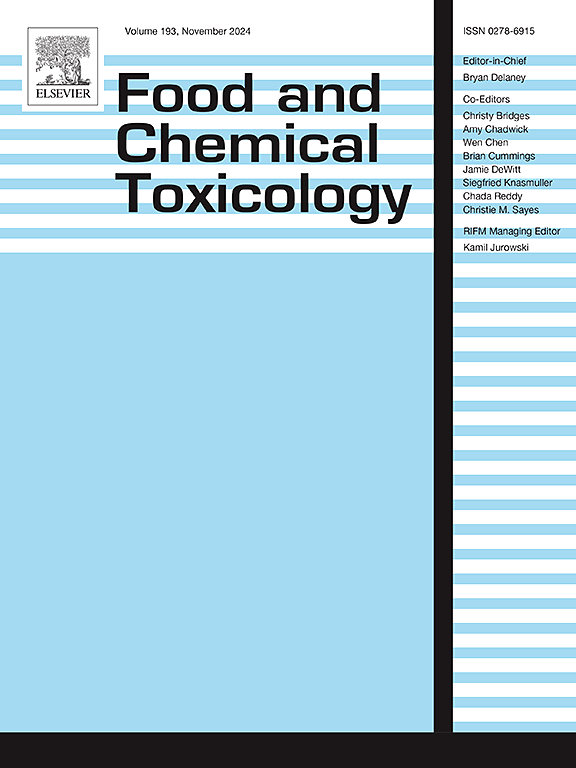Active compounds of licorice ameliorate microplastics-induced intestinal damage by targeting FADD
IF 3.9
3区 医学
Q2 FOOD SCIENCE & TECHNOLOGY
引用次数: 0
Abstract
Microplastics (MPs), as a novel type of environmental pollutant, have the potential to impact human health. This study aims to investigate the protective efficacy of active compounds in licorice on microplastics-injured rats and reveal the underlying mechanisms. The MPs-injured rat model was established by orally administrated with MPs. After the treatment with different doses of a combination of liquiritigenin, isoliquiritigenin and glycyrrhetinic acid, the tissue injury, oxidative stress, inflammation and expressions of tight junction proteins in colon and liver were evaluated. Our data showed that active compounds of licorice significantly ameliorate colonic and liver damage caused by MPs, improving function colonic barrier and liver function, reducing oxidative stress and systemic inflammatory factors. Then, a total of 29 differentially expressed proteins were identified by label-free proteomics analysis, among which the down-regulated Fas-associating protein with a novel death domain (FADD) was found to be the most related with the protective effects of licorice. What’s more, this protein target also interacts directly with active compounds of licorice, through hydrogen bounds and hydrophobic interactions involving 11 residues. This study suggested that licorice exerts protective effects against MPs on rats, through down-regulating as well as directly interacting with FADD.
甘草活性化合物通过靶向FADD改善微塑料诱导的肠道损伤
微塑料作为一种新型的环境污染物,对人类健康具有潜在的影响。本研究旨在探讨甘草中活性成分对微塑料损伤大鼠的保护作用及其机制。通过给药建立MPs损伤大鼠模型。采用不同剂量的利尿原素、异利尿原素和甘草次酸联合治疗后,观察大鼠结肠和肝脏组织损伤、氧化应激、炎症及紧密连接蛋白的表达情况。我们的数据显示,甘草的活性化合物可以显著改善MPs引起的结肠和肝脏损伤,改善结肠屏障和肝功能,降低氧化应激和全身炎症因子。然后,通过无标记蛋白质组学分析,共鉴定出29个差异表达蛋白,其中与甘草保护作用最相关的是下调的fas相关蛋白(FADD)。更重要的是,该蛋白靶点还通过涉及11个残基的氢键和疏水相互作用直接与甘草的活性化合物相互作用。本研究提示甘草对大鼠MPs具有保护作用,其机制可能是通过下调并直接与FADD相互作用。
本文章由计算机程序翻译,如有差异,请以英文原文为准。
求助全文
约1分钟内获得全文
求助全文
来源期刊

Food and Chemical Toxicology
工程技术-毒理学
CiteScore
10.90
自引率
4.70%
发文量
651
审稿时长
31 days
期刊介绍:
Food and Chemical Toxicology (FCT), an internationally renowned journal, that publishes original research articles and reviews on toxic effects, in animals and humans, of natural or synthetic chemicals occurring in the human environment with particular emphasis on food, drugs, and chemicals, including agricultural and industrial safety, and consumer product safety. Areas such as safety evaluation of novel foods and ingredients, biotechnologically-derived products, and nanomaterials are included in the scope of the journal. FCT also encourages submission of papers on inter-relationships between nutrition and toxicology and on in vitro techniques, particularly those fostering the 3 Rs.
The principal aim of the journal is to publish high impact, scholarly work and to serve as a multidisciplinary forum for research in toxicology. Papers submitted will be judged on the basis of scientific originality and contribution to the field, quality and subject matter. Studies should address at least one of the following:
-Adverse physiological/biochemical, or pathological changes induced by specific defined substances
-New techniques for assessing potential toxicity, including molecular biology
-Mechanisms underlying toxic phenomena
-Toxicological examinations of specific chemicals or consumer products, both those showing adverse effects and those demonstrating safety, that meet current standards of scientific acceptability.
Authors must clearly and briefly identify what novel toxic effect (s) or toxic mechanism (s) of the chemical are being reported and what their significance is in the abstract. Furthermore, sufficient doses should be included in order to provide information on NOAEL/LOAEL values.
 求助内容:
求助内容: 应助结果提醒方式:
应助结果提醒方式:


